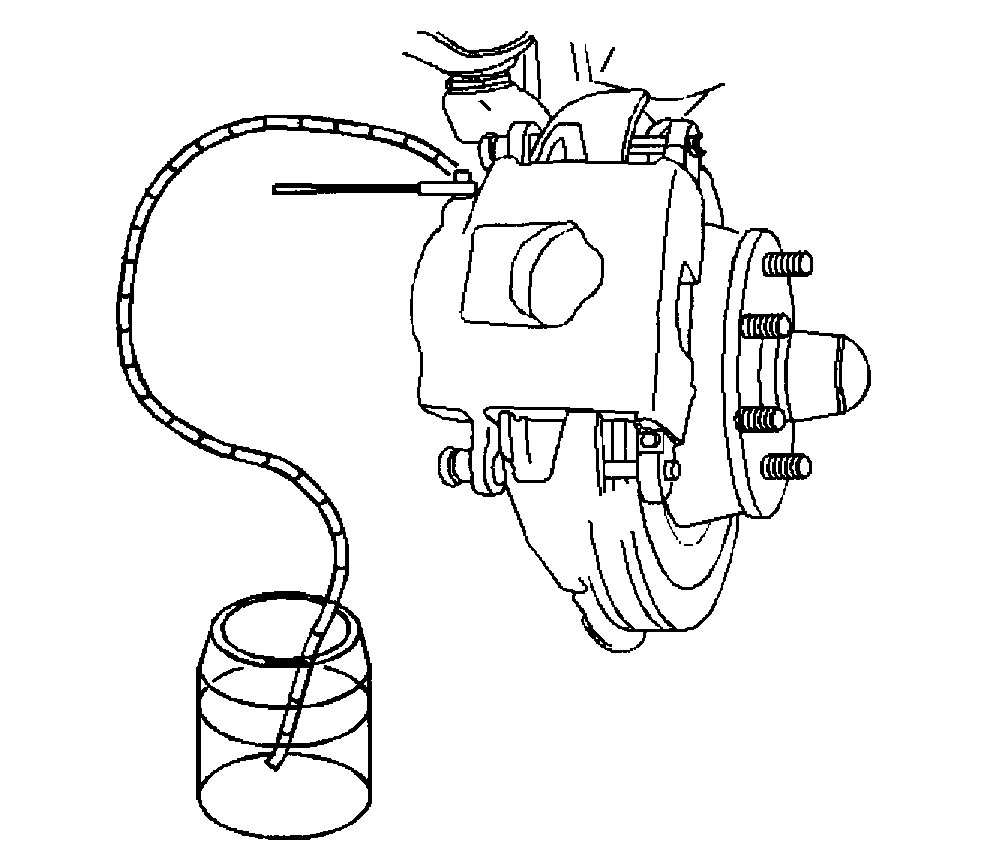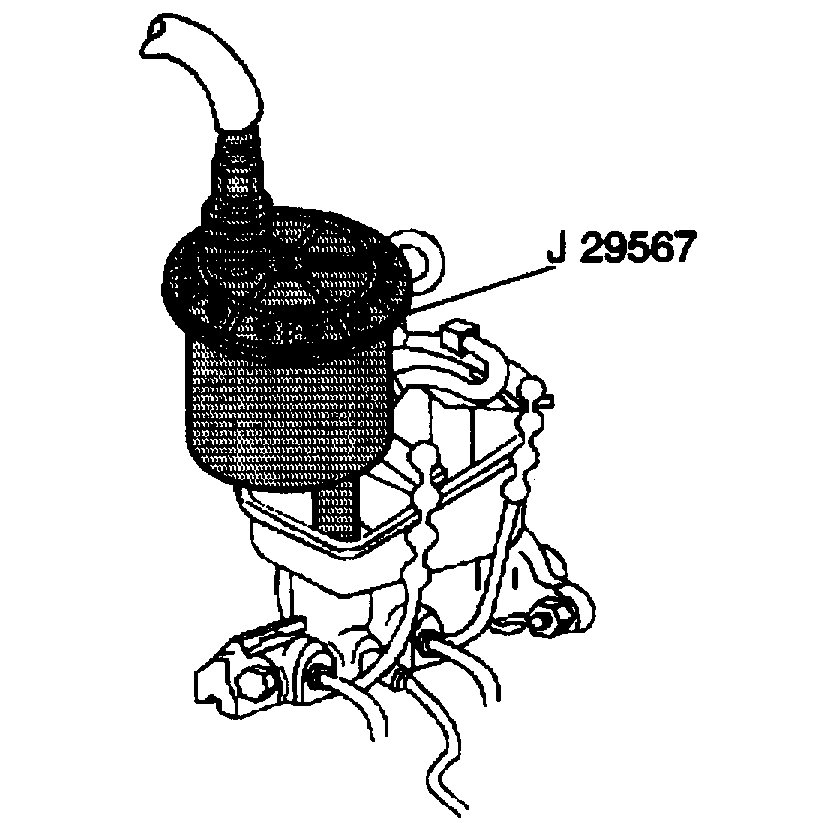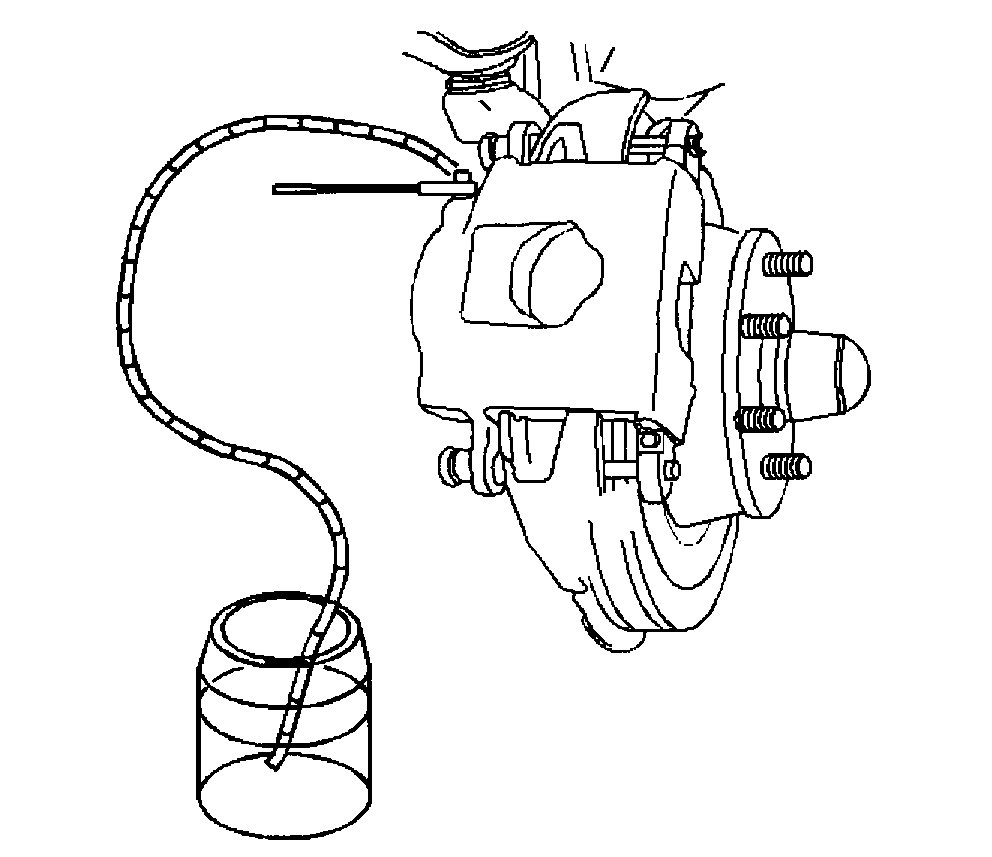Hi,
When you say plug, do you mean you eliminated the brake line?
Next, let me know the sequence and procedure you are using.
Here are the directions for manual or pressure bleeding. See if this is what you are doing.
_____________________________
1999 Chevy Truck K 1500 Suburban 4WD V8-5.7L VIN R
Manual and Pressure Bleeding Procedures
Vehicle Brakes and Traction Control Hydraulic System Brake Bleeding Service and Repair Procedures Manual and Pressure Bleeding Procedures
MANUAL AND PRESSURE BLEEDING PROCEDURES
pic 1
If air has entered the hydraulic brake system, bleed the system. You may need to bleed the hydraulic brake system at all four wheels due to one of the following conditions:
Air entered the system due to a low fluid level.
The brake pipes have been disconnected at the master cylinder.
The brake pipes have been disconnected at the combination valve.
If a pipe is disconnected at one wheel, then only bleed that wheel.
If the master cylinder has been removed, bleed the master cylinder before installing it on the vehicle. This will reduce the time required to bleed the system.
NOTICE: Brake fluid will damage electrical connections and painted surfaces. Use shop cloths, suitable containers, and fender covers to prevent brake fluid from contacting these areas. Always re-seal and wipe off brake fluid containers to prevent spills.
MANUAL BLEEDING
Tools Required
- J 28434 Wheel Cylinder Bleeder Wrench
1. If the vehicle has a vacuum booster, apply the brakes several times with the ignition OFF. This relieves the vacuum reserve.
2. Fill the master cylinder reservoir. Use Delco Supreme 11(R) Hydraulic Brake Fluid GM P/N 12377967, or equivalent DOT 3 motor vehicle brake fluid. Maintain the fluid level during bleeding.
3. If the master cylinder has air in the bore, bleed the master cylinder using the following procedure:
3.1. Disconnect the forward brake pipe connector at the master cylinder.
3.2. Allow the brake fluid to flow from the connector port.
3.3. Connect the brake pipe connector. Do not tighten the brake pipe connector.
3.4. Slowly apply the brake pedal. Allow the air to bleed from the loose connector.
3.5. Tighten the connector before releasing the brake pedal.
3.6. Wait 15 seconds.
3.7. Repeat this sequence, including the 15-second wait, until you purge all the air from the master cylinder bore.
3.8. Repeat this procedure for the rear brake pipe after you purge all the air from the forward pipe connection.
4. If you replaced the Brake Pressure Modulator Valve of the 4WAL system, or if you suspect that air is trapped inside, bleed the Brake Pressure Modulator Valve next.
5. Using J28434, bleed each wheel cylinder in the following sequence:
5.1. Right rear wheel cylinder
5.2. Left rear wheel cylinder
5.3. Right front wheel caliper
5.4. Left front wheel caliper
6. Attach a hose to the wheel cylinder/caliper bleeder valve.
7. Immerse the opposite end of the hose into a container partially filled with clean brake fluid.
8. Slowly apply the brake pedal one time and hold.
9. Loosen the bleeder valve in order to purge the air from the wheel cylinder/caliper.
NOTICE: Refer to Fastener Notice in Service Precautions.
10. Tighten the bleeder valve.
Tighten the bleeder valve to 13 Nm (110 inch lbs.).
11. Slowly release the brake pedal.
12. Wait 15 seconds.
13. Repeat this sequence, including the 15-second wait, until you purge all the air from the wheel cylinder or caliper.
14. Repeat steps 6-12 at each wheel until you purge all the air from the brake system.
15. Check the brake pedal for sponginess. Check the brake warning lamp for an indication of unbalanced pressure. Repeat the bleeding procedure in order to correct either of these conditions.
PRESSURE BLEEDING
Tools Required
- J 29567 Brake Bleeder Adapter
- J 28434 Wheel Cylinder Bleeder Wrench
pic 2
Use a diaphragm-type pressure bleeder. The pressure bleeder must have a rubber diaphragm between the air supply and the brake fluid. This prevents air, moisture, oil and other contaminants from entering the brake hydraulic system.
1. Fill the pressure tank at least 2/3 full of brake fluid.
2. Charge the pressure bleeder to 140 - 170 kPa (20 - 25 psi).
3. Bleed the pressure bleeder each time you add fluid.
4. Install the J 29567 Brake Bleeder Adapter to the master cylinder.
5. If the Brake Pressure Modulator Valve of the 4WAL system is replaced, or if you suspect that air is trapped inside, bleed the Brake Pressure Modulator Valve first.
6. Using J28434, bleed each wheel cylinder or caliper in the following sequence:
6.1. Right rear wheel cylinder
6.2. Left rear wheel cylinder
6.3. Right front wheel caliper
6.4. Left front wheel caliper
7. Connect the hose from the bleeder to the adapter at the master cylinder.
8. Open the tank valve.
9. Attach a hose to the bleeder valve.
Pic 3
10. Immerse the opposite end of the hose into a container partially filled with clean brake fluid.
11. Slowly open the bleeder valve at least 3/4 of a turn. Allow the fluid to flow until you see no air in the fluid.
NOTICE: Refer to Fastener Notice in Service Precautions.
12. Tighten the wheel cylinder or caliper bleeder valve.
Tighten the wheel cylinder or caliper bleeder valve to 13 Nm (110 inch lbs.).
13. Check the brake pedal for sponginess. Repeat the bleeding procedure if the brake pedal is spongy.
14. Repeat steps 9 - 12 at every wheel.
15. Disconnect the hose from the bleeder adapter.
16. Remove the J 29567 Brake Bleeder Adapter.
17. Fill the master cylinder to the proper level.
_________________________
Now, there is a good chance the ABS system will need bled. THis will require an automated bleed procedure. Here are the directions for that.
________________________
1999 Chevy Truck K 1500 Suburban 4WD V8-5.7L VIN R
Automated Bleed Procedure
Vehicle Brakes and Traction Control Hydraulic System Brake Bleeding Service and Repair Procedures Automated Bleed Procedure
AUTOMATED BLEED PROCEDURE
IMPORTANT:
Use the two-person bleed procedure under the following conditions:
- Installing a new Electro-Hydraulic Control Unit (EHCU) or new Brake Pressure Modulator Valve (BPMV).
- Air is trapped in the valve body
Do not drive the vehicle until the brake pedal feels firm.
Do not reuse brake fluid that is used during bleeding.
Use the vacuum, the pressure and the gravity bleeding procedures only for base brake bleeding.
TWO PERSON PROCEDURE
1. Raise the vehicle in order to access the system bleed screws.
2. Bleed the system at the right rear wheel first.
3. Install a clear hose on the bleed screw.
4. Immerse the opposite end of the hose into a container partially filled with clean DOT 3 brake fluid.
5. Open the bleed screw 1/2 to one full turn.
6. Slowly depress the brake pedal. While the pedal is depressed to its full extent, tighten the bleed screw.
7. Release the brake pedal and wait 10 - 15 seconds for the master cylinder pistons to return to the home position.
8. Repeat the previous steps for the remaining wheels. The brake fluid which is present at each bleed screw should be clean and free of air.
9. This procedure may use more than a pint of fluid per wheel. Check the master cylinder fluid level every four to six strokes of the brake pedal in order to avoid running the system dry.
10. Press the brake pedal firmly and run the Scan Tool Automated Bleed procedure (below 15,000 GVW) once, or run the Function Test (above 15,000 GVW) four times. Release the brake pedal between each test.
11. Bleed all four wheels again using Steps 3 - 9. This will remove the remaining air from the brake system.
12. Evaluate the feel of the brake pedal before attempting to drive the vehicle.
13. Bleed the system as many times as necessary in order to obtain the appropriate feel of the pedal.
__________________________
Keep in mind, if you can not get a brake pedal, there are no leaks, you repaired the brake line, and there is no air in the system after doing the above procedures, the master cylinder may have been damaged.
Let me know if I can help or if you have other questions.
Take care,
Joe
Images (Click to make bigger)
Monday, March 15th, 2021 AT 11:26 AM






